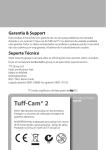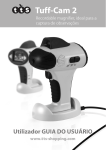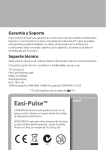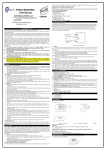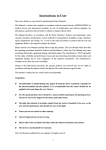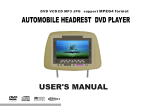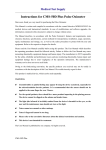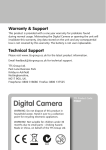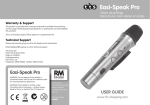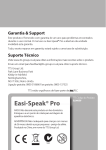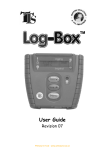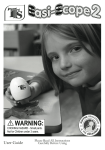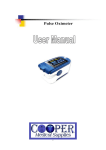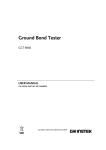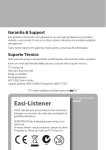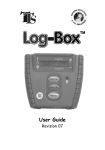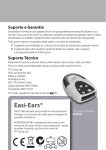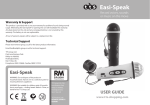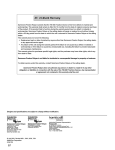Download Easi-PulseTM
Transcript
Warranty & Support This product is provided with a one year warranty for problems found during normal usage. Mistreating the Easi-Pulse or opening the unit will invalidate this warranty. Any data stored on the unit and any consequential loss is not covered by this warranty. The battery is not user replaceable. Technical Support Please visit www.tts-group.co.uk for the latest product information. Email [email protected] for technical support. TTS Group Ltd. Park Lane Business Park Kirkby-in-Ashfield Nottinghamshire, NG17 9GU, UK. Freephone: 0800 318686 Freefax: 0800 137525 TTS Product Code: Easi-Pulse TM WARNING: Do not dispose of this product in household waste. Hand it over to a collection point for recycling electronic appliances. WARNING! Not suitable for children under 36 months due to small parts – choking hazard. Made in China, on behalf of the TTS Group Ltd. Nxxxxx N448 EL00145 Easi-Pulse TM measures the pulse oxygen saturation and pulse rate USER GUIDE www.tts-shopping.com Instructions to User Dear users, thank you very much for purchasing the Pulse Oximeter. This Manual is written and compiled in accordance with the council directive MDD93/42/EEC for medical devices and harmonized standards. In case of modifications and software upgrades, the information contained in this document is subject to change without notice. The Manual describes, in accordance with the Pulse Oximeter’s features and requirements, main structure, functions, specifications, correct methods for transportation, installation, usage, operation, repair, maintenance and storage, etc. as well as the safety procedures to protect both the user and equipment. Refer to the respective chapters for details. Please read the User Manual carefully before using this product. The User Manual which describes the operating procedures should be followed strictly. Failure to follow the User Manual may cause measuring abnormality, equipment damage and human injury. The manufacturer is NOT responsible for the safety, reliability and performance issues and any monitoring abnormality, human injury and equipment damage due to users’ negligence of the operation instructions. The manufacturer’s warranty service does not cover such faults. Owing to the forthcoming renovation, the specific products you received may not be totally in accordance with the description of this User Manual. We would sincerely regret for that. This product is medical device, which can be used repeatedly. 2 Easi-Pulse TM WARNING: n Uncomfortable or painful feeling may occur if using the device continuously, especially for microcirculation barrier patients. It is recommended that the sensor is applied for no longer than 2 hours. n The device cannot be clipped on the edema or tender tissue. n Do not attempt to look directly at the infra-red light emitter. n Remove all cosmetics from the finger nail before use. n Please refer to literature about the clinical restrictions and caution. n This device is not intended for medical treatment. The User Manual is published by Contec Medical Systems Co., LTD. All rights reserved. 3 CONTENTS 4 1 Safety 5 1.1 Instructions for safe operation 5 1.2 Warnings 5 1.3 Attention 6 2 Overview 6 2.1 Features 6 2.2 Major applications and scope of application 7 2.3 Environment requirements 7 3 Principle 7 4 Technical specifications 8 4.1 Main performance 8 4.2 Main Parameters 8 5 Installation 9 5.1 View of the front panel 9 5.2 Battery installation 10 5.3 Accessories 10 6 Operating Guide 10 6.1 Application method 10 6.2 Operation 15 6.3 Clinical restrictions 15 7 Maintain transportation and storage 15 7.1 Cleaning 15 7.2 Maintainance 15 7.3 Transportation and storage 13 8 Troubleshooting 16 9 Key of Symbols 17 10 Function Specification 18 Appendix 19 Easi-Pulse TM 1 Safety 1.1 Instructions for safe operations Check the main unit and all accessories periodically to make sure that there is no visible damage that may affect patient’s safety and check cables. It is recommended that the device should be inspected once a week. When there is obvious damage, stop using the device. n Necessary maintenance must be performed by qualified service engineers ONLY. There are no user serviceable parts and users are not permitted to maintain it by themselves. n The oximeter cannot be used together with devices not specified in User’s Manual. Only the accessory that appointed or recommendatory by manufacture can be used with this device. n This product is calibrated before leaving factory. 1.2 Warning n Explosive hazard—DO NOT use the oximeter in an environment with inflammable gas such as some ignitable anesthetic agents. n Ensure that the environment in which the device is operated is not subject to any sources of strong electromagnetic interference, such as radio transmitters, mobile telephones, etc. n DO NOT use the oximeter during MRI and CT scans. n Plastics contain rubber that some users may be allergic to. n The disposal of the instrument and its accessories and packaging (including battery, plastic bags, foams and paper boxes) should follow the local laws and regulations. n Please check the packing before use to make sure the device and accessories are in accordance with the packing list. n Please choose the accessories and probe which are approved or manufactured by the manufacturer, other devices or accessories may damage the device. 5 1.3 Attention n Keep the oximeter away from dust, vibration, corrosive substances, explosive materials, high temperature and moisture. n If the oximeter gets wet, stop use. n The Oximeter should be left to acclimatize to different environments. n DO NOT the operate keys on front panel with sharp materials. n High temperature or high pressure steam disinfection of the oximeter is not recommended. n Do not expose the Oximeter to liquids. n When cleaning the device with water, the temperature should be lower than 60°C. n The update period of data is less than 5 seconds. n Please read the measured value when the waveform on screen is equal and steady. This measured value is optimal value. n If some abnormal symbols appear on the screen during use, pull out the finger and reinsert to restore normal use. n This device has an alarm, users can check on this function according to chapter 6.2 as a reference. n A flexible circuit connects the halves of the device. Do not twist or pull on the connection. 2 Overview The pulse oxygen saturation is the percentage of HbO2 in the total Hb in the blood, so-called the O2 concentration in the blood. It is an important bio-parameter for respiration. A number of diseases relating to respiratory system may cause a decrease of SpO2 in the blood. 2.1 Features A. Operation of the product is simple and convenient. B. The product is compact, light in weight and convenient to carry. C. Low power consumption 2.2 Major applications and scope of application The Pulse Oximeter can be used in measuring the pulse oxygen saturation 6 Easi-Pulse TM and pulse rate through finger. The product is suitable for being used at home, in the hospital, at an oxygen bar, in community healthcare, and for physical care in sports (it can be used before or after sports, it is not recommended to use the device during sport) and etc. 2.3 Environment requirements Storage Environment a) Temperature :-40°C +60°C b) Relative humidity :5% 95% c) Atmospheric pressure :500hPa 1060hPa Operating Environment a) Temperature:10°C 40°C b) Relative Humidity :30% 75% c) Atmospheric pressure:700hPa 1060hPa 3 Principle Principle of the Oximeter is as follows: using Lambert Beer Law and according to Spectrum Absorption Characteristics of Reductive Hemoglobin (Hb) and Oxyhemoglobin (HbO2) in glow & near-infrared zones. Operation principle of the device is: Photoelectric Oxyhemoglobin Inspection Technology is adopted in accordance with Capacity Pulse Scanning & Recording Technology, so that two beams of different wavelength of lights can be focused onto human nail tip through perspective clamp finger-type sensor. Then the measured signal can be obtained by a photosensitive element, information acquired through which will be shown on screen. Glow and Infraredray Emission tube Glow and Infraredray Receit tube 7 4 Technical specifications 4.1 Main performance A. SpO2 value display B. Pulse rate value display, bar graph display C. Pulse waveform display D. Low-voltage indication E. Automatically power off: it will automatically power off within 5 seconds if the finger falls out of probe. F. The display mode can be changed G. A pulse rate sound indication H. Alarm function I. With SpO2 value and pulse rate data storage, the stored data can be uploaded to computers J. Data can be transmitted to computers 4.2 Main Parameters A. Measurement of SpO2 Measuring range: 0% 100 Accuracy: When the SpO2 measuring range is 70% 100,the permission of absolute error is ±2 below 70% unspecified B. Measurement of pulse rate Measuring range:30bpm 250bpm Accuracy: ±2 bpm or ±2% (select larger) C. Resolution SpO2 : 1%, Pulse rate: 1bpm. 8 Easi-Pulse TM D. Measurement Performance in Weak Filling Condition SpO2 and pulse rate can be shown correctly when pulse-filling ratio is 0.4%. SpO2 error is ±4%, pulse rate error is ±2 bpm or ±2% (select larger). E. Resistance to surrounding light The deviation between the value measured in the condition of man-made light or indoor natural light and that of darkroom is less than ±1%. F. Power supply requirement: 2.6 V DC ~ 3.6V DC. G. Optical Sensor Red light (wavelength is 660nm 6.65mW) Infrared (wavelength is 880nm, 6.75mW) H. Adjustable alarm range: SpO2 0%~100% Pulse Rate: 0bpm~250bpm 5 Installation 5.1 View of the front panel 9 5.2 Battery installation A. Refer to Figure 3. and insert the two AAA size batteries with the correct polarity. B. Replace the cover. Figure 3 5.3 Accessories A. Lanyard C. User manual B. Two dry batteries (AAA) (optional) D. USB lead E. CD (PC software) 6 Operating Guide 6.1 Application method A. a) Insert the two batteries ensuring the correct polarity, and then replace the cover. b) Open the clip as shown in Figure 4. c) Insert the finger into the foam rubber cushions of the clip (make sure the finger is in the right position), and then release the clip onto the finger. 10 d) The data can be read directly from the screen on the measuring interface. Figure 4 Put finger in position Easi-Pulse TM B. Change display direction On the measuring interface, press the button to change the display. C. Pause alarm: a) Alarm including can be set to sound for data going beyond the predetermined limits, low battery, and finger removed. c) To turn off the alarm, setting can be changed in the operation menu. D. Data transmission setting Firstly, please install the affiliated software onto the computer, two icons will appear on the desktop after installation. SpO2 is a program for receiving real-time data which is shown as Figure 5; the icon of SpO2 Review is a program for receiving stored data which is shown as Figure 6. a. Please connect the device to the computer with the USB lead , then double click the “SpO2 “icon to start the program. b. When you unplug the USB lead from the computer, a dialog box will appear “Save data at view” on the desktop, at this point you will be prompted to input basic user information if required. E. Menu operations Figure 5 SpO2 program Figure 5 SpO2 Review program 11 On the measuring interface, the display direction can be changed by pressing the power button quickly. There are six modes of data display that can be viewed. a. Adjusting the high and low limits of alarms On the alarm setting interface, Click the power button to select “Dir”, then Press and hold the power button (1 second) to enter the Settings Menu Interface (see Figure 7). The user can setup the following parameters in the Settings Menu – Turn on alarm; turn on pulse sound, alarm high-low limits, data storage (recording). Please note in the Settings Menu: Figure 7 CLICK = short press of power button and PRESS = prolonged push of power button (1sec) a) Alarm setting On the main menu interface, click the power button to select “Alarm”, Press the power button (1sec) to enter the alarm setting interface as shown in Figure 8: Figure 8 12 Easi-Pulse TM Press the button (1sec) to enter the alarm direction setting interface as shown in Figure 9: On the alarm direction setting interface, Click the power button to select “SpO2 Alm”or “PR Alm”, then Press the button (1 sec) to enter the SpO2 or PR direction setting interface as shown in Figure 10: Click the power button to select “Dir”, then Press the button to choose Up or Down (this will be the direction the value of the high-low limits of SpO2 and pulse rate will be adjusted) Figure 9 To raise the SpO2 and pulse rate limit, choose “Dir” as ‘Up’, then Click the power button to select high limit (High) or low limit (Low), Press the power button and hold to adjust the Figure 10 selected limit to the desired higher value and release the power button once the higher limit has been reached. To lower the SpO2 and pulse rate limit, choose “Dir” as ‘Down’, then Click the power button to select high limit (High) or low limit (Low). Press the power button and hold to adjust the selected limit to the desired lower value and release the power button once the lower limit has been reached. b. Pulse sound indication setting On the alarm setting interface as shown in Figure 8, Click the power button to select “Psound”, then Press the power button to choose to have the Pulse Sound (heart beat) alarm “on” or “off”. 13 c. The alarm state setting On the alarm setting interface as shown in Figure 8, Click the power button to select “Alarm”, then Press the power button to choose alarm on or off, press “ on” to turn on the alarm and “ off” to turn off the alarm. d. Exit the Alarm settings , the alarm direction setting , the SpO2 or PR direction setting Click the power button to select “Exit”, then Press the power button to exit the Menu and return to the previous Menu . b Data storage setting This instrument has the ability to store 24 hours worth of data. It can store the measured pulse rate and SpO2 values, transfer the data to a computer, display the data and print reports (with the included SpO2 Software - Green Heart) a. On the main menu interface as shown in Figure 7, Click the button to select “Record”, then press the button to choose whether to store the data or not, choose “on” to allow storing, choose “off ” to prevent storing. b. If the data storage is turned on, the main user interface will show a flashing yellow dot. c. Whilst recording the screen will be automatically shut down, with only the flashing yellow dot to indicate that the device is recording. d. Data is automatically written over if not uploaded. e. When the storage space is full, the device will display “Memory is full” on the screen, and then shut down after 3 seconds. c Uploading the data to the PC after recording a. Connect the device to a computer via the USB lead supplied with the device, then double click “SpO2 Review” icon to launch the software. Click the ‘New Session’ Icon in the software, enter the patient data and then click ‘ok’. The Software will then display “device connected, waiting for data”. b. On the main menu interface on the device recording mode must be off. d Exit the main menu On the main menu interface, Click the button to select “Exit”, then press the 14 button to exit the main menu. Easi-Pulse TM F. Power off The device will power off automatically when it gets no signal for 5 seconds. The device cannot power off when it is storing data. 6.2 Attention for operation A. Please check the device before use. B. The finger should be in a proper position (see the attached illustration of Figure 4 for reference), or else it may result in an inaccurate measurement. C. The SpO2 sensor should not be used at a location or with a limb with an arterial canal or blood pressure cuff or whilst receiving intravenous injection. D. Do not fix the SpO2 sensor with adhesive. E. Excessive ambient light may affect the measuring result. F. Strenuous action of the subject or extreme electrosurgical interference may also affect the accuracy. G. Please clean and disinfect the device after operating according to the User Manual(7.1). 6.3 Clinical restrictions A. Some medical conditions will affect the SpO2 reading by this monitor and may be inaccurate. 7 Maintenance, transportation and storage 7.1 Cleaning and Disinfecting Use medical alcohol to disinfect the device, nature dry or clean it with clean soft cloth. 7.2 Maintenance A. Please clean and disinfect the device before using according to the User Manual(7.1). B. Please change the battery when the screen shows. C. Remove the battery from the device for long periods of storage. 15 7.3 Transportation and storage A. There are not special transportation requirements. B. The packed device should be stored in room with: Temperature: -40°C~60°C; Humidity: ≤95% Troubleshooting The SpO2 and Pulse Rate cannot be read 1. The finger is not properly positioned 1. Place the finger properly and try again. 2. The patient’s SpO2 is too low to be detected. 2. Try again; Go to a hospital for a diagnosis if you are sure the device works all right. The SpO2 and Pulse Rate are not displayed stably 1. The finger is not placed inside deep enough. 1. Place the finger properly and try again. 2. The finger is shaking or the patient is moving. 2. Let the patient keep calm. The device will not turn on 1. The battery is flat. 1.Please change batteries. 2.Please Install the battery again. 2. The battery is installed incorrectly. 3. The device is faulty. The display switches off suddenly 1. This device is set to automatically power off after 5 seconds when it cannot detect any signal. 2. The battery is flat. 16 3. Please contact distributer. 1. Ensure finger is correctly inserted 2. Please change batteries. Easi-Pulse TM 9 Key of Symbols Warning – See User Manual %SpO2 The pulse oxygen saturation(%) PRbpm Pulse rate (bpm) Low-voltage Open the alarm sound indication Open the pulse sound indication menu button/power button/function button Type BF SN --- Serial number 1. the finger clip falls off ( no finger inserted)] 2. Probe error 3. Signal inadequacy indicator battery positive battery negative USB IPXI Ingress of liquids rank WEEE (2002/96/EC) This item is compliant with Medical Device Directive 93/42/EEC of June 14, 1993, a directive of the European Economic Community. 17 The Pulse Oxygen Saturation (SpO2) 2-digit digital OLED display Pulse Rate(PR) 3-digit digital OLED display Pulse Intensity (bar-graph) bar-graph SpO2 Parameter Specification OLED display Measuring range 0%-100%, (the resolution is 1%). Accuracy 70%-100% ±2% , Below 70% unspecified. Average value Calculate the Average value in every 4 measure value. The deviation between average value and true value does not exceed 1%. Pulse Parameter Specification Measuring range Accuracy Average pulse rate 30bpm-250bpm, (the resolution is 1bpm) ±2bpm or±2% (select larger) Moving calculate the Average pulse rate every 4 cardio-beats cycle. The deviation between average value and true value does not exceed 1% Safety Type Pulse Intensity Interior Battery, BF Type Range Battery Requirement Continuous bar-graph display, the higher display indicates the stronger pulse. Battery working life 1.5V (AAA size) alkaline batteries × 2 18 Two 1.5V (AAA size) 600mAh alkaline batteries can work continually for 24 hours Easi-Pulse TM Dimensions and Weight Dimensions 58.5(L) × 31(W) × 32 (H) mm Weight About 52g (with the batteries) Appendix Guidance and manufacturer’s declaration – electromagnetic emissionsfor all Equipment and Systems Guidance and manufacturer’s declaration – electromagnetic emission The CMS50D+ is intended for use in the electromagnetic environment specified below. The customer of the user of the CMS50D+ should assure that it is used in such and environment. Emission test Compliance Electromagnetic environment – guidance RF emissions CISPR 11 Group 1 The CMS50D+ uses RF energy only for its internal function. Therefore, its RF emissions are very low and are not likely to cause any interference in nearby electronic equipment. RF emission CISPR 11 Class B The CMS50D+ is suitable for use in all establishments other than domestic and those directly connected to a low voltage power supply network which supplies buildings used for domestic purposes. 19 Guidance and manufacturer’s declaration – electromagnetic immunity – for all Equipment and Systems Guidance and manufacturer’s declaration – electromagnetic immunity The CMS50D+ is intended for use in the electromagnetic environment specified below. The customer or the user of CMS50D+ should assure that it is used in such an environment. Immunity test IEC 60601 test level Compliance level Electromagnetic environment guidance Electrostatic discharge (ESD) ±6 kV contact ±8 kV air ±6 kV contact ±8 kV air Floors should be wood, concrete or ceramic tile. If floor are covered with synthetic material, the relative humidity should be at least 30%. 3A/m 3A/m Mains power quality should be that of a typical commercial or hospital environment. IEC 61000-4-2 Power frequency (50/60Hz) magnetic field IEC 61000-4-8 NOTE UT is the a.c. mains voltage prior to application of the test level. 20 Easi-Pulse TM Immunity test IEC 60601 test level Compliance level Electromagnetic environment guidance Radiated RF IEC 610004-3 3 V/m 80 MHz to 2.5 GHz 3 V/m Portable and mobile RF communications equipment should be used no closer to any part of the CMS50D+, including cables, than the recommended separation distance calculated from the equation applicable to the frequency of the transmitter. Recommended separation distance 80 MHz to 800 MHz 800 MHz to 2.5 GHz Where P is the maximum output power rating of the transmitter in watts (W) according to the transmitter manufacturer and d is the recommended separation distance in metres (m). Field strengths from fixed RF transmitters, as determined by an electromagnetic site survey,a should be less than the compliance level in each frequency range b. Interference may occur in the vicinity of equipment marked with the following symbol: 21 NOTE 1 At 80 MHz and 800 MHz, the higher frequency range applies. NOTE 2 These guidelines may not apply in all situations. Electromagnetic propagation is affected by absorption and reflection from structures, objects and people. a Field strengths from fixed transmitters, such as base stations for radio (cellular/cordless) telephones and land mobile radios, amateur radio, AM and FM radio broadcast and TV broadcast cannot be predicted theoretically with accuracy. To assess the electromagnetic environment due to fixed RF transmitters, an electromagnetic site survey should be considered. If the measured field strength in the location in which the CMS50D+ is used exceeds the applicable RF compliance level above, the CMS50D+ should be observed to verify normal operation. If abnormal performance is observed, additional measures may be necessary, such as reorienting or relocating the CMS50D+. b Over the frequency range 150 kHz to 80 MHz, field strengths should be less than 3 V/m. 22 Easi-Pulse TM Recommended separation distances between portable and mobile RF communications equipment and the CMS50D+ The CMS50D+ is intended for use in an electromagnetic environment in which radiated RF disturbances are controlled. The customer or the user of the CMS50D+ can help prevent electromagnetic interference by maintaining a minimum distance between portable and mobile RF communications equipment (transmitters) and the CMS50D+as recommended below, according to the maximum output power of the communications equipment. Rated maximum output power of transmitter (W) Separation distance according to frequency of transmitter (m) 80 MHz to 800 MHz 800 MHz to 2.5 GHz 0.01 0.12 0.23 0.1 0.37 0.74 1 1.17 2.33 10 3.69 7.38 100 11.67 23.33 For transmitters rated at a maximum output power not listed above, the recommended separation distance d in metres (m) can be estimated using the equation applicable to the frequency of the transmitter, where P is the maximum output power rating of the transmitter in watts (W) according to the transmitter manufacturer. NOTE 1 At 80 MHz and 800 MHz, the separation distance for the higher frequency range applies. NOTE 2 These guidelines may not apply in all situations. Electromagnetic propagation is affected by absorption and reflection from structures, objects and people. 23
























